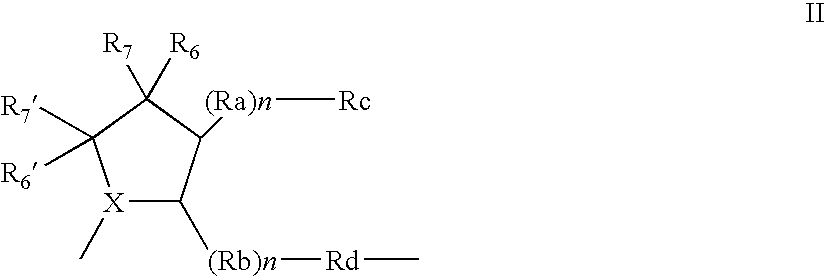Organic compounds
a technology of organic compounds and compounds, applied in the field of organic compounds, can solve the problems of tumor cells capable of evading programmed cell death and often becoming resistant to treatment, and achieve the effects of avoiding the development and progression of tumor cells, and avoiding the development of tumor cells
- Summary
- Abstract
- Description
- Claims
- Application Information
AI Technical Summary
Benefits of technology
Problems solved by technology
Method used
Image
Examples
example 1
N-[1-cyclohexyl-2-oxo-2-(6-phenethyl-octahydro-pyrrolo[2,3-c]pyridin-1-yl)-ethyl]-2-methylamino-propionamide (9)
[0385] Compound 9 according to Formula I is prepared according to the procedure set forth in Scheme 5.
[0386] 1-(1-Naphthalen-1-yl-ethyl)-aziridine-2-carboxylic acid methyl ester (1). To a solution of (S)-(−)-1-(1-naphthyl)ethylamine (20.8 g, 120 mmol) in acetonitrile (HPLC grade, 600 mL) is added K2CO3 (52.7 g, 360 mmol) and methyl 2,3-dibromopropionate (30 g, 120 mmol). The solution is stirred overnight at room temperature. The solution is evaporated to dryness, then H2O / EtOAc (1:1) (600 mL) is added, and the mixture is extracted with EtOAc (4×100 mL). The organic extracts are combined, dried and concentrated under vacuum. The residue is purified by flash chromatography (silica gel; Hexane / EtOAc 1:2) to provide 24 g (78%) of the title compound as a mixture of two diastereomers in an equimolecular ratio. M+H+=256.10.
[0387] But-3-enyl-phenethyl-amine (2). To a solution ...
example 2
(S)-N-((S)-1-Cyclohexyl-2-{(2S,3R)-2-[(ethyl-phenethyl-amino)-methyl]-3-methyl-pyrrolidin-1-yl}-2-oxo-ethyl)-2-methylamino-propionamide (23)
[0394]
[0395] But-3-enyl-((S)-1-phenyl-ethyl)-amine (A): To a solution of S-(−)-1-phenyl ethylamine (15.75 g, 130 mmol) in 150 mL of DMF at 0° C. is added K2CO3 (53.9 g, 390 mmol) in small portions. After stirring at 0° C. for 10 min, 4-bromobutene (13.5 g, 100 mmol) is added dropwise and followed by Nal (58.5 g, 390 mmol) in small portions. The reaction mixture, a white suspension, is heated to 95° C. and stirred overnight / 16 hrs. The solution is cooled to RT and diluted with 200 mL of ether, and washed with 3×100 ml of water. The organic layer is dried over Na2SO4 and concentrated. The crude product is purified by distillation (65˜70° C. under high vacuum) to yield a colorless liquid(13.5 g, 76.7%). (NMR and MS data confirmed, U-4117-28-23).
[0396] [But-3-enyl-((S)-1-phenyl-ethyl)-amino]-acetic acid ethyl ester (B): To a solution of But-3-enyl...
example 3
[0406]
[0407] Diphenethylamine (D). To a solution of phenylacetaldehyde (6.0 g, 50 mmol) and 2-phenylethylamine in THF (200 mL) is added sodium triacetoxy-borohydride drop wise. The solution is stirred under nitrogen overnight at room temperature. The solution is quenched with aq. saturated sodium bicarbonate (200 mL), and extracted with EtOAc (4×100 mL). The organic extracts are combined, dried and concentrated under vacuum. The residue is purified by flash chromatography (silica gel; EtOAc / MeOH 9:1) to provide 1.25 g (11%) of the compound D as a clear oil. M+H+=226.10.
[0408] Diphenethyl-(S)-1-pyrrolidin-2-ylmethyl-amine (E). To a solution of (S)-2-Formyl-pyrrolidine-1-carboxylic acid tert-butyl ester (1.0 g, 5.0 mmol) and D (1.125 g, 5.0 mmol) in THF (40 mL) is added sodium triacetoxyborohydride drop wise. The solution is stirred under nitrogen overnight at room temperature. The solution is quenched with aq. saturated sodium bicarbonate (40 mL). The mixture is extracted with EtOAc...
PUM
 Login to View More
Login to View More Abstract
Description
Claims
Application Information
 Login to View More
Login to View More - R&D
- Intellectual Property
- Life Sciences
- Materials
- Tech Scout
- Unparalleled Data Quality
- Higher Quality Content
- 60% Fewer Hallucinations
Browse by: Latest US Patents, China's latest patents, Technical Efficacy Thesaurus, Application Domain, Technology Topic, Popular Technical Reports.
© 2025 PatSnap. All rights reserved.Legal|Privacy policy|Modern Slavery Act Transparency Statement|Sitemap|About US| Contact US: help@patsnap.com



